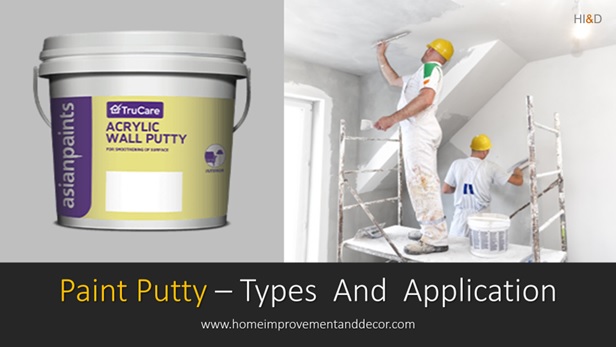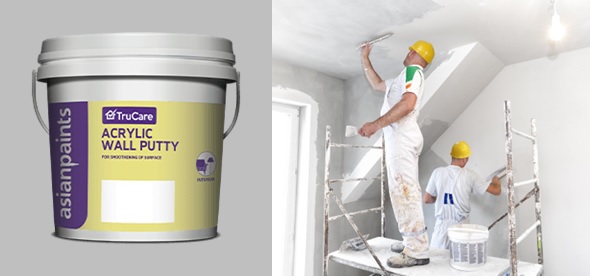
Paint Putty
Paint Putty Types And Applications
Wall Putty , Wood Putty , Metal Putty
Paint putty is a type of filler used to prepare surfaces for painting. It is a smooth and creamy substance that can be applied to surfaces such as walls, woodwork, metal surfaces, and plaster to fill in small cracks, dents, and holes.
The purpose of using paint putty is to create a smooth and even surface for painting and to ensure that the paint adheres well to the surface. In other words, the paint putty works as a foundation for the surface to be painted. And therefore, paint putty plays an important role in the painting process to achieve desirable results.
Different types of paint putty are available for various applications. Depending upon the type and nature of the surface to be painted, appropriate paint putty can be applied.
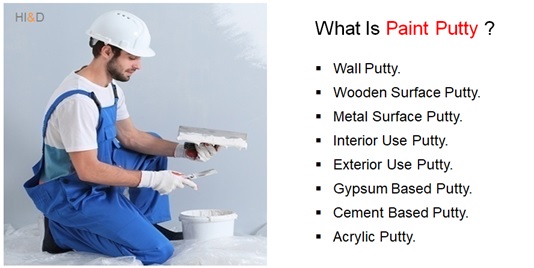
Paint putty can be made from a variety of materials, such as gypsum, calcium carbonate, cement, acrylic, or clay, and mixed with water and other additives to create a pliable, workable paste.
It is typically applied with a putty knife or trowel, and then smoothed and shaped to match the surface it is filling. Once the putty is dry, it can be sanded to create an even smoother surface, ready for painting.
Paint putty is an important tool for any home improvement DIY or professional painting project, as it helps to create a professional-looking finish and ensure that the paint job lasts longer by preventing paint from cracking or flaking due to underlying surface imperfections.
Guide To Paint Putty Types And Applications
Complete Guide To Paint Putty
Table Of Contents
Learn what is paint putty , different types of putty and how to select putty for specific application. Complete paint putty guide for the students of architecture, interior design, civil engineering, civil contractors and other stake holders.
Types Of Paint Putty
Different types of paint putty are available for various applications. The selection of the paint putty depends upon the type of the surface to be painted and other requirements.
Based on the type of surface, the paint putty can be:
- Wall Surface Putty.
- Wooden Surface Putty.
- Metal Surface Putty.
Similarly, based On the exposure to environmental factors such as rainfall, sunlight and other factors, the paint putty can be grouped into two main types as under:
- Interior Grade Paint Putty.
- Exterior Grade Paint Putty.
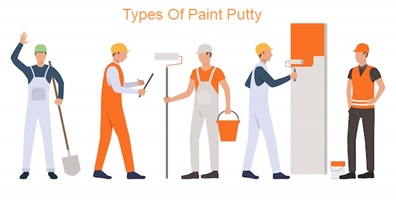
Guide To Paint Putty Types And Applications
How To Apply Paint Putty ?
Applying paint putty on a surface before painting helps to fill in any imperfections, smooth out the surface, and create an even base for the paint to adhere to. The number of layers to be applied depends upon the type of surface and the extent of cracks and other imperfections.
Here are the steps to apply paint putty on a surface:
- Clean the surface: Before applying the putty, make sure the surface is clean and free of any dirt, dust, or grease. You can use a damp cloth to wipe the surface clean.
- Prepare the putty: Take a small amount of putty and mix it well until it becomes smooth and consistent. You can use a putty knife or a spatula to mix the putty.
- Apply the putty: Using a putty knife or a spatula, apply the putty to the surface in a thin layer. Work in small sections and apply the putty evenly. Make sure to fill any cracks, holes, or imperfections in the surface.
- Smooth the putty: After applying the putty, use a putty knife or a spatula to smooth out the surface. Make sure the putty is evenly spread and there are no bumps or ridges.
- Let the putty dry: Allow the putty to dry completely before sanding or painting. The drying time will depend on the type of putty you are using, so make sure to read the instructions on the package.
- Sand the putty: Once the putty is dry, use sandpaper to smooth out the surface. Start with a coarse grit sandpaper and work your way up to a finer grit sandpaper. Make sure the surface is smooth and even.
- Clean the surface: After sanding, wipe the surface clean with a damp cloth to remove any dust or debris.
Your surface is now ready to be painted! Make sure to choose a high-quality paint and follow the instructions carefully for the best results.
What Is Wall Putty ?
Wall putty is applied either on newly plastered wall surface or on the existing painted surface. It is advisable to completely remove the existing paint. However, this option depends upon the condition of the existing paint.
Wall putty is a white cement-based powder that is used for making the surface of walls smooth and even before painting. It is applied on the surface of walls to fill in any small cracks, dents, or imperfections on the surface of the wall. Wall putty also helps to provide a consistent and smooth finish to the wall, which is important for achieving a perfect paint job.
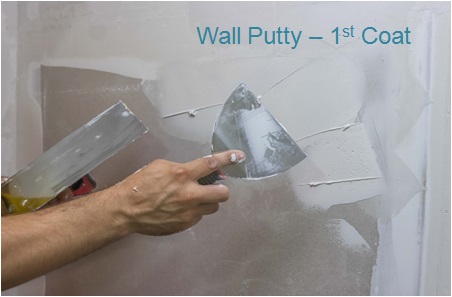
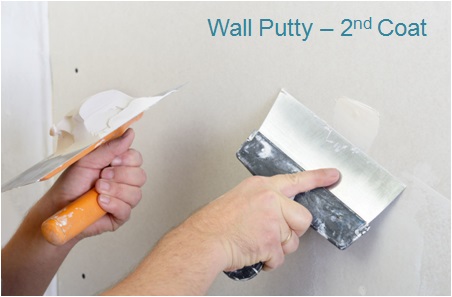
Wall putty is typically applied to the surface of the wall after the wall has been plastered, but before it is painted. It is mixed with water to form a smooth paste, which is then applied to the wall using a putty knife or trowel. The putty is then allowed to dry and harden, after which it can be sanded down to create a smooth, even surface.
Wall putty is commonly used in construction and renovation projects, particularly in homes and offices. It is available in different grades, depending on the quality of finish required and the level of smoothing required on the wall. It is important to choose the right grade of wall putty depending on the surface to be covered, as using the wrong type of putty can lead to cracking or flaking of the paint.
Guide To Paint Putty Types And Applications
Interior Grade Paint Putty
Interior wall putty is a type of wall putty that is specifically designed for use on the interior walls of a building. It is used to fill in any cracks or imperfections on the surface of the wall, and to create a smooth and even surface for painting or wallpapering.
Interior wall putty is typically made from a blend of white cement, fillers, and polymers, which gives it a smooth and creamy consistency. It is easy to apply using a putty knife or trowel, and it dries quickly to form a hard, durable surface.
One of the main benefits of using interior wall putty is that it helps to hide any imperfections on the surface of the wall, such as small cracks, dents, or holes. This makes it an ideal choice for renovating old walls, or for creating a smooth and even surface on new walls.
Interior wall putty is also resistant to moisture, which makes it a good choice for use in areas that are prone to humidity, such as bathrooms or kitchens. It is also easy to sand down and paint over, which makes it a popular choice for DIY enthusiasts and professional painters alike.
Overall, interior wall putty is a versatile and effective way to create a smooth and even surface on the interior walls of a building, and it is an essential part of any interior renovation or painting project.
Exterior Grade Paint Putty
Exterior wall putty is a type of wall putty that is specifically designed for use on the exterior walls of a building. It is used to fill in any cracks or imperfections on the surface of the wall, and to create a smooth and even surface for painting or other decorative finishes.
Unlike interior wall putty, exterior wall putty is formulated to withstand harsh weather conditions such as rain, wind, and UV rays. It is made with special additives that provide additional strength, durability, and resistance to moisture and temperature changes.
Exterior wall putty is typically made from a blend of white cement, fillers, and acrylic polymers, which give it excellent adhesion and water-resistant properties. It is applied using a trowel or putty knife, and it dries quickly to form a hard, durable surface.
One of the main benefits of using exterior wall putty is that it helps to protect the surface of the wall from the elements, which can help to prolong the life of the building. It also provides a smooth and even surface for painting or other decorative finishes, which can enhance the appearance of the building and increase its value.
Overall, exterior wall putty is an essential part of any exterior renovation or painting project, and it can help to ensure that the building looks great and stays protected for years to come.
Wooden Surface Paint Putty
Wood surface putty is a type of putty used to fill cracks, holes, and gaps in wooden surfaces, such as wooden wall surface, plywood surface, wooden boards, furniture, doors, windows, and flooring. It is specifically designed for use on wood, as it has unique properties that allow it to bond well with the natural fibers of the wood.
Wood surface putty is typically made from a blend of natural or synthetic resins, fillers, and solvents. It comes in a variety of colours to match the colour of the wood, and it can be stained or painted over once it dries.
To use wood surface putty, the surface of the wood should be cleaned and dried thoroughly. The putty is then applied using a putty knife, and any excess putty is wiped away with a damp cloth. Once the putty has dried, it can be sanded down to create a smooth and even surface.
One of the main benefits of using wood surface putty is that it helps to restore the appearance of the wood by filling in any gaps or cracks. It can also help to protect the wood from further damage by preventing moisture and insects from getting into the wood through gaps or cracks.
Overall, wood surface putty is an essential part of any wood restoration or repair project, and it can help to ensure that the wood looks great and stays protected for years to come.
Metal Surface Paint Putty
Metal surface putty is a type of putty used to fill cracks, holes, and gaps in metal surfaces, such as automotive bodywork, metal furniture, appliances, and machinery. It is specifically designed for use on metal, as it has unique properties that allow it to bond well with the surface of the metal.
Metal surface putty is typically made from a blend of resin, hardener, and fillers. It comes in a variety of colors to match the color of the metal, and it can be sanded, drilled, and painted over once it dries.
To use metal surface putty, the surface of the metal should be cleaned and dried thoroughly. The putty is then mixed according to the manufacturer’s instructions and applied to the surface of the metal using a putty knife. The putty is then allowed to dry and harden, after which it can be sanded down to create a smooth and even surface.
One of the main benefits of using metal surface putty is that it helps to restore the appearance of the metal by filling in any gaps or cracks. It can also help to protect the metal from further damage by preventing moisture and rust from getting into the metal through gaps or cracks.
Overall, metal surface putty is an essential part of any metal repair or restoration project, and it can help to ensure that the metal looks great and stays protected for years to come.

